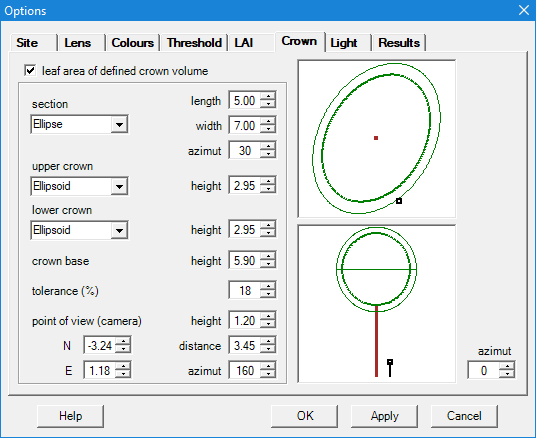
In order to calculate the leaf area of a single tree, its crown geometry has to be specified, so that Hemisfer will be able to estimate the distance to the dark pixels belonging to that crown. Within the options, the "crown" tab looks like this:

The crown has to be entered as two parts, an upper part and a lower part. Imagine first that you cut the crown at the height where it has its maximal width. The shape of this horizontal cut is called section and has to be specified. There are two types of sections in Hemisfer, either an ellipse or a rectangle. While the ellipse can accomodate for most tree crowns (including the special case of being a circle), the rectangle may be appropriate for some shapes of trees in orchards. The size of the section is defined by its length and width. The last thing that defines the section is its orientation, its geographical azimut. While the user enters all these parameters, the shape of the section is visible as a small map.
Upper crown and lower crown can be defined next, first by their shape, then by their height (their vertical extent). The 3D shape of each crown part is defined independently, enabling to adjust the whole crown shape with quite some freedom. In the example depicted here, both the upper and lower part of the crown are chose as ellipsoids, but it would for example also be possible to choose a high conic shape for the upper crown to come close to the shape of many conifers. Last thing necessary to define the crown is the height of its base, i.e. the height of the trunk at which the crown begins. The resulting tree shape can be observed as a side view, which can be rotated by adjusting the viweing azimut (at the lower right).
A further parameter is a tolerance in the size of the crown. This tolerance is meant to include branches that extend beyound the main part of the crown, building a less dense envelope around it. Use this tolerance if you want to include such an envelope with few branches inside. It can be entered as a single parameter: its size (in %) relative to that of the main crown.
The position of the camera has also to be defined. It has to be entered relatively to the basis of the tree trunk (if the trunk is not vertical, then relatively to the point on the ground that is under the center of the crown). Horizontally, this position can be given by cartesian coordinates (northing and easting) or by polar coordinates (distance and azimut). Changing one set of coordinates automatically changes the other one. In the vertical direction, the height of the camera has to be entered. The position of the camera can also be checked on the small map and the small side view (small black square).